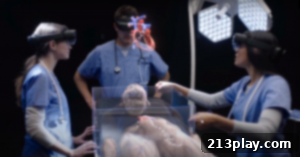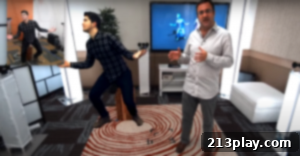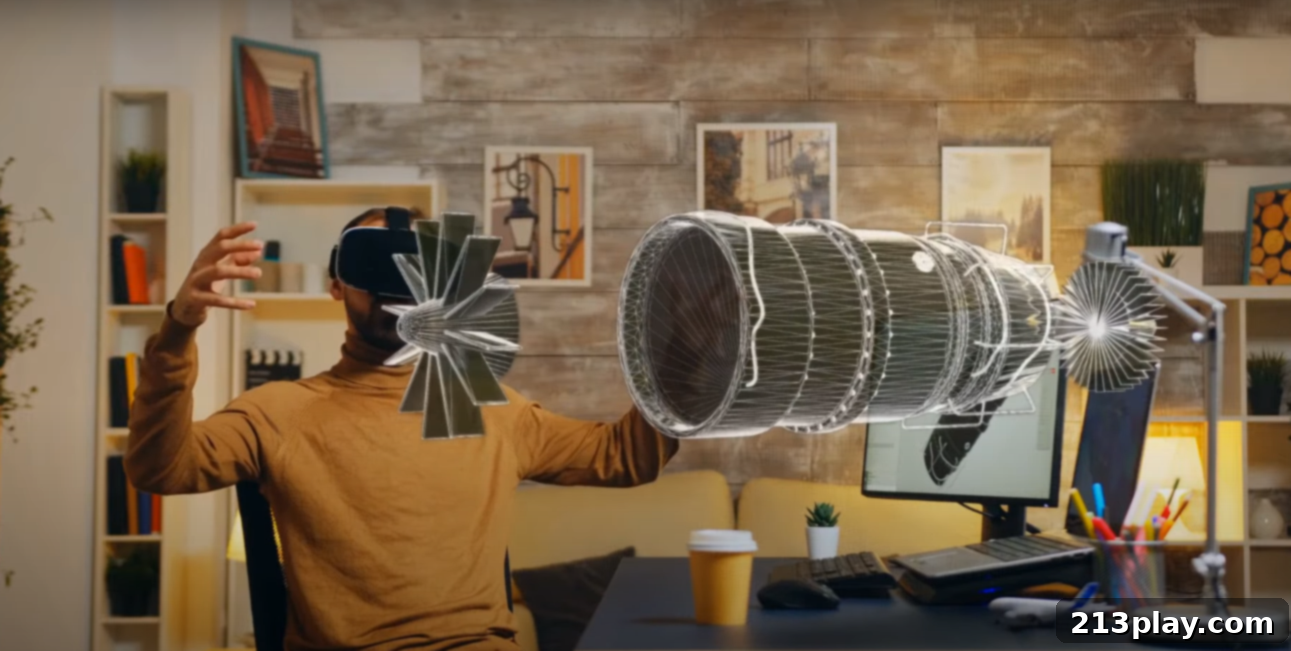MR vs XR: A Comprehensive Guide to Mixed Reality and Extended Reality Technologies
Table of Contents
MR vs XR: The Immersive Landscape Explained
In the rapidly evolving world of immersive technologies, terms like Virtual Reality (VR), Augmented Reality (AR), Mixed Reality (MR), and Extended Reality (XR) are frequently discussed. While VR and AR have become somewhat familiar, MR and XR represent the next frontier, pushing the boundaries of how humans interact with digital content and the physical world. This article aims to clearly differentiate Mixed Reality (MR) from Extended Reality (XR), delving into their unique characteristics, diverse applications, and their collective role as catalysts for a profound “virtual revolution.” Gaining a clear understanding of these distinctions is paramount for anyone navigating the future of digital interaction, from technology enthusiasts and developers to business leaders and consumers.
Building upon our previous discussion about the fundamental differences between Virtual Reality versus Augmented Reality, we now embark on a deeper exploration of the more advanced variations within the immersive spectrum. Both MR and XR are not merely incremental technological advancements; they represent significant paradigm shifts in how we perceive, interact with, and ultimately shape our environment. These technologies are blurring the lines between the digital and the physical to create truly integrated, highly interactive, and profoundly impactful experiences across virtually every sector.
Mixed Reality Characteristics: Blending Digital and Physical Worlds

Mixed Reality (MR) is a fascinating technological advancement that effectively bridges the gap between the fully simulated worlds of Virtual Reality and the superimposed digital elements of Augmented Reality. It creates an environment where physical and digital objects coexist and interact in real-time, blurring the distinction between what is real and what is virtual. Unlike AR, where digital elements are merely overlaid onto the real environment without true interaction with physical objects, MR takes this concept to a sophisticated level, enabling users to actively manipulate, engage with, and even be obstructed by these virtual objects as if they were physically present.
For instance, imagine using an MR device to place a virtual sofa in your living room. In AR, you would see the sofa, but it might appear to float unrealistically or not interact with your existing furniture. In MR, you could walk around the virtual sofa, push it, resize it with natural hand gestures, or even change its material and color. Crucially, the virtual sofa would cast shadows on your real floor and disappear behind a physical table, demonstrating a deep understanding of the environment. This profound level of interaction is made possible by advanced spatial computing capabilities, which allow MR devices to precisely map and understand the user’s physical surroundings, including surfaces, obstacles, and lighting conditions. This environmental awareness enables virtual content to behave realistically within the real world.
Key Features Defining Mixed Reality:
- Seamless Blending and Real-time Interaction: The hallmark of MR is its ability to seamlessly integrate virtual and real-world elements, allowing for bidirectional interaction. Virtual objects react to the physics and lighting of the real world, and users can actively manipulate digital content using intuitive interfaces like hand gestures, gaze, or voice.
- Environmental Understanding and Spatial Anchoring: MR devices are equipped with sophisticated sensors (e.g., depth cameras, accelerometers, gyroscopes) that scan and create a 3D map of the user’s physical environment. This “spatial understanding” enables virtual objects to be accurately positioned, scaled, and anchored to specific points in the real world, maintaining their stability even as the user moves.
- Persistent Digital Content: Unlike transient AR overlays, virtual objects placed in an MR environment can remain in their designated locations, even if the user leaves the space and returns, or if multiple users view the same environment. This persistence is fundamental for collaborative applications and building stable augmented realities.
- Holographic Computing: Many MR systems project digital information as holograms that appear to exist in the real world. These holograms are not just flat images but 3D objects that can be viewed from different angles and depths, responding to ambient light and real-world occlusion.
- Enhanced Collaboration: MR significantly boosts collaborative potential, allowing geographically dispersed teams to work together on shared virtual 3D models or designs within a common mixed reality space. This creates a powerful sense of co-presence and facilitates collective problem-solving as if participants were in the same physical room.
The core promise of MR is to augment not just what we see, but how we interact with and reshape our perceived reality, paving the way for intuitive human-computer interaction that transcends traditional screens and input devices.
Mixed Reality Applications: Real-World Impact Across Industries

Mixed Reality is rapidly evolving from an experimental technology to an indispensable tool across a diverse range of industries, offering innovative solutions and significantly enhancing operational efficiency. Its unique ability to merge interactive digital content with the physical world opens up a vast array of practical applications:
- Construction and Architecture: MR technology is revolutionizing infrastructure planning, design, and execution. Architects and construction companies can create hyper-realistic “virtual building models” that can be superimposed directly onto construction sites or existing structures. This allows for real-time visualization of designs in context, early identification of potential conflicts, and collaborative design reviews with stakeholders, ensuring greater accuracy and efficiency before any physical construction begins. For example, construction workers can view holographic blueprints overlaid onto unfinished structures, guiding them through complex assembly processes.
- Medical Practice and Training: In the healthcare sector, MR offers groundbreaking capabilities for both training and practice. Surgeons can perform complex surgical simulations on highly detailed virtual patient models, gaining invaluable hands-on experience for intricate procedures like tumor removal or heart transplants without any risk to real patients. MR also enables remote surgical assistance, where expert surgeons can provide real-time holographic annotations and instructions to local practitioners during an operation, enhancing precision and knowledge transfer. Furthermore, it improves patient education, helping individuals visualize their conditions and understand proposed treatments in a far more intuitive and engaging manner.
- Gaming and Entertainment: While immersive gaming is an evident application, MR elevates it beyond traditional VR experiences. Games like Beat Saber utilize MR principles by blending virtual challenges with the player’s physical space. Players use motion controllers to slash at virtual blocks to the beat of music, physically dodging obstacles in their actual play area. This creates a highly engaging and active gaming experience that uniquely combines digital fun with physical movement. Other MR games allow users to transform their living rooms into interactive digital battlefields or care for virtual pets that respond to real-world cues.
- Manufacturing and Engineering: MR devices, such as the Microsoft HoloLens, are invaluable in manufacturing. They provide frontline workers with holographic work instructions overlaid directly onto machinery for assembly, maintenance, and quality assurance tasks, drastically reducing training time, human error, and increasing efficiency. Engineers can collaboratively review 3D prototypes in real-time, making instant design adjustments that are immediately reflected in a shared virtual model, thereby accelerating product development cycles.
- Education and Vocational Training: MR transforms learning into an interactive, hands-on experience. Students can dissect virtual organs, explore historical sites in 3D, or conduct complex scientific experiments in a safe virtual laboratory setting. This contextual, experiential learning significantly improves comprehension, retention, and skill development across various disciplines.
- Retail and E-commerce: MR enhances the shopping experience by allowing customers to virtually “try on” clothing, visualize furniture or appliances in their homes before purchase, or explore detailed 3D models of products. This leads to more confident buying decisions, reduces product returns, and creates a more engaging retail journey.
The ecosystem supporting MR continues to expand rapidly. Leading devices like the Microsoft HoloLens and the Lenovo Explorer are at the forefront. Microsoft, in particular, has fostered a robust development environment, including a comprehensive 3D virtual stock library, enabling users and developers to easily access and integrate a vast array of digital assets into their MR overlays, further accelerating adoption and innovative applications.
Extended Reality Characteristics: The Ultimate Immersive Spectrum

Extended Reality (XR) stands as the ultimate umbrella term, encompassing the entire spectrum of immersive technologies: Virtual Reality (VR), Augmented Reality (AR), and Mixed Reality (MR), along with any future advancements that blend the real and virtual worlds. XR represents a visionary leap towards a future where the distinction between our physical environment and digital content is not just blurred but potentially dissolved. Its ambition is to offer experiences that range from completely virtual to deeply augmented physical, all interconnected and responsive. The ultimate vision for XR is to evolve into an integrated extension or even a replacement of physical reality, leveraging “data as the actual sixth sense.”
This concept of “data as the sixth sense” implies that our interactions with digital information will become as intuitive and natural as our interactions with the physical world through our traditional five senses. Imagine not just seeing and hearing a virtual object, but also feeling its texture, smelling its essence, or even tasting it, all powered by sophisticated data streams and multi-sensory feedback systems. XR seeks to create a seamless continuum of experience, allowing users to effortlessly transition between purely digital and highly augmented physical realms without jarring disconnections or requiring separate devices.
XR is designed to create environments that are not only visually and auditorily immersive but also respond dynamically to our physical presence and cognitive input. It strives to make the virtual world react with us as deeply as we interact with it, fostering truly dynamic and adaptive experiences. The underlying infrastructure for such advanced reality relies heavily on cutting-edge technologies like 5G and Artificial Intelligence (AI), which provide the essential ultra-low latency, massive bandwidth, and sophisticated processing power necessary to render, manage, and intelligently adapt these complex, real-time, multi-sensory digital environments. This powerful synergy of technologies is designed to deliver “out-of-this-world” experiences or empower individuals to create entirely personalized virtual worlds of their own.
Defining Traits of Extended Reality:
- All-Encompassing Spectrum: XR is the overarching category for all immersive technologies, meaning any new development that blends real and virtual falls under its umbrella. This signifies a holistic approach to defining the future of human-computer interaction.
- Deep Multi-Sensory Immersion: While VR typically focuses on sight and sound, XR aims for a complete sensory experience. This includes highly advanced haptic feedback for touch, olfactory systems for smell, and even gustatory feedback for taste, creating a profoundly believable and engaging virtual presence.
- Intelligent and Responsive Environments: Leveraging AI, XR experiences are designed to be dynamic and adaptive. They can respond to user behavior, emotional states, environmental context, and even physiological data in real-time, leading to more personalized and intuitive interactions.
- Seamless Reality Transition: A core promise of XR is the ability for users to transition effortlessly between different levels of immersion – from being fully present in the physical world with AR overlays, to interacting in a blended MR environment, and finally to being fully transported into a VR world – often within the same integrated system.
- Convergence of Advanced Technologies: XR is fundamentally powered by the convergence of 5G connectivity (for ultra-high bandwidth and low latency), Artificial Intelligence (AI) for intelligent content generation and processing, sophisticated sensors for precise tracking and input, and advanced rendering engines for hyper-realistic visuals.
- Enhanced Human Presence and Cognition: XR seeks to extend human capabilities and presence beyond physical limitations. This means fostering a profound sense of “being there” in virtual spaces, enhancing cognitive functions through dynamic digital overlays, and enabling truly global, embodied collaboration with realistic avatars and digital representations.
- “Data as a Sixth Sense” Integration: This philosophical characteristic posits that digital data will become an intrinsic part of our perception and interaction, allowing us to interpret and engage with information in ways as natural and fundamental as our biological senses.
The vision for XR is nothing short of revolutionary, promising to fundamentally alter how we work, learn, play, and connect, ushering in an era where reality itself becomes a malleable canvas for human ingenuity and experience.
Extended Reality Applications: Reshaping Industries and Everyday Life

Extended Reality (XR) is poised to initiate a fundamental paradigm shift across virtually every aspect of human endeavor. By encompassing and integrating the full spectrum of immersive technologies—VR, AR, and MR—XR is set to redefine how we interact with digital information, collaborate, learn, and even perceive our daily lives. Its potential impact is so vast that it suggests a future where entire industries are not just transformed, but fundamentally reshaped.
- The Future of Work and Global Collaboration: XR promises to revolutionize the concept of work entirely. The notion that “when everybody works remotely, there is no remote work; there is just work” encapsulates this transformation. Businesses, offices, factories, and various organizations can transition into highly efficient remote-first or hybrid models, while maintaining an unparalleled sense of presence and collaboration. Imagine global teams convening in hyper-realistic virtual offices, interacting with 3D models, intricate data visualizations, and digital twins of physical assets as if they were physically co-located. This will foster unprecedented efficiency, drastically reduce travel costs, and expand talent pools globally. Advanced XR applications will enable architects to walk through unbuilt structures, engineers to collaborate on complex designs in real-time, and field technicians to receive dynamic holographic guidance for maintenance and repairs, all while physically separated.
- Advanced Healthcare and Holistic Wellness: Building upon the significant strides made by MR in healthcare, XR will elevate medical practice and wellness to new dimensions. Surgeons can practice ultra-complex procedures with haptic feedback that precisely simulates tissue resistance and physiological responses, preparing them with unmatched realism. Remote expert surgeons can guide operations with unprecedented fidelity through shared XR spaces. For patient wellness, advanced XR ecosystems (envisioned by concepts like a sophisticated “Tesla Suite,” as suggested in the original text, representing a deeply integrated personal XR environment) could continuously monitor physiological data such as heart rate, temperature, sleep patterns, and stress levels in real-time within the virtual environment. This data, intelligently analyzed by AI, could offer personalized health insights, facilitate early disease detection, power highly engaging rehabilitation therapies with virtual exercises, and even manage chronic pain through immersive distraction techniques. While offering immense benefits, this pervasive level of personal data tracking also necessitates robust ethical frameworks and stringent privacy controls to safeguard user information.
- Revolutionary Education and Experiential Training: XR promises to revolutionize learning by creating deeply immersive, interactive, and experiential educational environments. Students could undertake virtual field trips to ancient civilizations or distant galaxies, conduct dangerous scientific experiments safely in a digital lab, or learn complex technical skills through hyper-realistic simulations that adapt dynamically to their progress. Medical students could perform virtual dissections with realistic anatomy, while vocational trainees could practice operating heavy machinery without physical risk, leading to significantly higher engagement, retention, and practical skill acquisition.
- Hyper-Immersive Entertainment and Social Interaction: Beyond current VR games, XR will usher in an era of hyper-immersive entertainment and social experiences. It will enable full-sensory storytelling, virtual concerts with haptic feedback that simulates vibrations and crowd energy, and social platforms where users feel a genuine sense of embodied presence and connection with others. Imagine attending a live concert from your living room, seeing your friends’ avatars beside you, and feeling the bass reverberating through a haptic suit.
- Next-Generation Retail, E-commerce, and Product Design: XR will redefine how consumers shop and how products are designed. Consumers will be able to virtually browse elaborate showrooms, customize products in 3D, and ‘try on’ clothes that conform perfectly to their digital avatars. Designers and engineers can collaborate on virtual prototypes, instantly iterating on designs and presenting them to clients in fully immersive, interactive environments, drastically shortening design cycles and reducing physical prototyping costs.
- Defense and Public Safety: XR offers unparalleled training simulations for military personnel, first responders, and emergency services. These simulations can replicate high-stress, dangerous scenarios with extreme realism, allowing individuals to practice critical decision-making, team coordination, and operational procedures in a safe, controlled environment, thereby significantly enhancing readiness and effectiveness.
The widespread adoption of Extended Reality will not just change how we use technology; it will fundamentally alter our perception of reality, creating dynamic, personalized digital extensions of our world. As these technologies mature, their integration will become increasingly seamless, making the distinction between physical and digital less relevant, and paving the way for unprecedented innovation across all aspects of life.
Virtual Revolution Technology: The Future is Now

The ongoing evolution of virtual technologies – encompassing Virtual Reality (VR), Augmented Reality (AR), Mixed Reality (MR), and the expansive umbrella of Extended Reality (XR) – is fundamentally revolutionizing our worldviews and interactions. These technologies have transcended mere novelty to become powerful tools that simplify complex tasks, enable seamless data monitoring and implementation, and ultimately redefine the boundaries of human experience. This is the profound essence of the virtual revolution: an era where digital constructs are integrated so deeply into our lives that they augment our natural capabilities and perception. As these immersive technologies continue to advance, they increasingly offer the potential to influence, and to a significant extent, shape aspects of our reality, from enhancing cognitive functions to enabling unparalleled remote presence and collaboration.
The race to innovate in the immersive technology space is intense, with major players and agile startups alike making significant contributions. Companies like Sony are leveraging their extensive expertise in gaming and entertainment to develop cutting-edge XR headsets that seamlessly integrate with powerful platforms like the PlayStation 5, promising high-fidelity graphics and deeply immersive gameplay experiences. Meta (formerly Facebook) continues its aggressive investment in its Reality Labs division, pushing the boundaries with its widely adopted Oculus Quest line and aiming to build the foundational infrastructure for a fully realized metaverse – a persistent, interconnected virtual universe for work, play, and social interaction. Beyond these, industry giants such as Apple, Google, and Valve are also making substantial strides, each contributing unique hardware, software, and platform innovations to accelerate the development and widespread adoption of XR.
However, a pivotal enabler of this expansive immersive future is Qualcomm, which has strategically positioned itself at the forefront of the XR hardware revolution. Through its leading Snapdragon XR platforms, Qualcomm designs the advanced chipsets that power many of today’s and tomorrow’s sophisticated XR devices. These platforms are meticulously optimized for crucial foundational technologies like 5G connectivity, ensuring ultra-low latency and massive bandwidth essential for seamless, real-time immersive experiences, and integrated Artificial Intelligence (AI) for intelligent content generation, environmental understanding, and adaptive user interfaces. Qualcomm’s holistic approach, spanning from silicon to comprehensive software development frameworks, is absolutely critical for the widespread deployment and sustained success of robust XR ecosystems across various industries.
The advancements propelling XR extend far beyond the headsets themselves. A rapidly growing ecosystem of peripheral devices is emerging to bridge the sensory gap between digital and physical realities, striving for complete immersion. This includes highly sophisticated haptic gloves that allow users to “feel” the texture, weight, and resistance of virtual objects with remarkable realism, providing unprecedented tactile feedback. Cutting-edge research is even exploring artificial skin technologies designed to convey sensations like temperature, pressure, and vibrations, making virtual touch virtually indistinguishable from physical contact. Precision eye-tracking and facial recognition technologies are becoming standard, enabling avatars to mirror user emotions and intentions with uncanny accuracy, fostering deeper and more authentic social connections in virtual spaces. Other groundbreaking innovations include omnidirectional treadmills for unrestricted physical movement within expansive virtual worlds, and nascent brain-computer interfaces (BCIs) that hint at a future where digital environments can be manipulated by thought alone, fundamentally reshaping human-computer interaction.
This unprecedented surge in technological development is creating a pressing demand for a completely new professional discipline: Reality Engineering. In the expansive and interactive landscapes of XR, users are no longer passive observers; they are active participants, making dynamic decisions and collaboratively shaping their digital experiences. Reality Engineers will be the visionary architects and builders of these immersive worlds, responsible for designing and developing experiences that are not only technologically robust but also psychologically engaging, ethically sound, and socially meaningful. Recognizing this critical need for specialized talent and standardized development, Qualcomm, as a leading XR technology provider, has launched its XR Optimized Certification Program. This initiative aims to foster excellence in XR development, ensuring high-quality, seamless, and interoperable user experiences across the diverse array of upcoming XR devices. The future of reality is rapidly unfolding, layer by immersive layer, promising a world where the boundaries of possibility are continuously redefined and expanded through the power of Extended Reality.
